
The National Register of Historic Places (NRHP) is the United States federal government's official list of sites, buildings, structures, districts, and objects deemed worthy of preservation for their historical significance or "great artistic value".
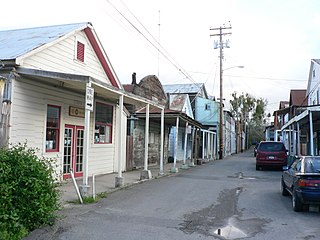
Locke, also known as Locke Historic District, is an unincorporated community in the Sacramento–San Joaquin River Delta of California, United States. The 14-acre town (5.7 ha) was first developed between 1893 and 1915 approximately one mile north of the town of Walnut Grove in Sacramento County.

Locust Point is a peninsular neighborhood in Baltimore, Maryland. Located in South Baltimore, the neighborhood is entirely surrounded by the Locust Point Industrial Area; the traditional boundaries are Lawrence street to the west and the Patapsco River to the north, south, and east. It once served as a center of Baltimore's Polish-American, Irish-American and Italian-American communities; in more recent years Locust Point has seen gradual gentrification with the rehabilitation of Tide Point and Silo Point. The neighborhood is also noted as being the home of Fort McHenry and the western end of its namesake tunnel that carries eight lanes of Interstate 95 under the river.

Ebey's Landing National Historical Reserve is a unit of the National Park Service on Whidbey Island in the Puget Sound, near Coupeville in Island County, Washington, United States.

This is a list of properties and districts in Illinois that are on the National Register of Historic Places. There are over 1,900 in total. Of these, 85 are National Historic Landmarks. There are listings in all of the state's 102 counties.
This National Park Service list is complete through NPS recent listings posted December 20, 2024.
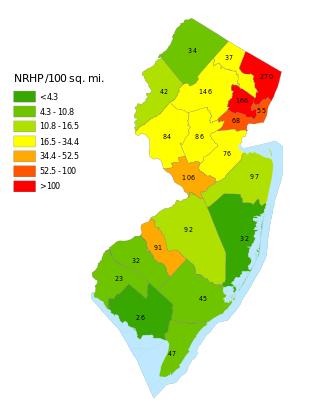
This is a list of properties and districts listed on the National Register of Historic Places in New Jersey. There are more than 1,700 listed sites in New Jersey. Of these, 58 are further designated as National Historic Landmarks. All 21 counties in New Jersey have listings on the National Register.
This National Park Service list is complete through NPS recent listings posted December 20, 2024.

The Judah P. Benjamin Confederate Memorial at Gamble Plantation Historic State Park, also known as the Gamble Mansion or Gamble Plantation, is a Florida State Park, located in Ellenton, Florida, on 37th Avenue East and US 301. It is home to the Florida Division United Daughters of the Confederacy (UDC).

Leesylvania State Park is located in the southeastern part of Prince William County, Virginia. The land was donated in 1978 by businessman Daniel K. Ludwig, and the park was dedicated in 1985 and opened full-time in 1992.
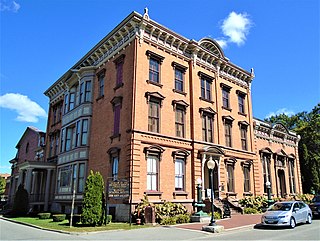
Canfield Casino and Congress Park is a 17-acre (6.9 ha) site in Saratoga Springs, New York, United States. It was formerly the site of the Congress Hotel, a large resort hotel, and the Congress Spring Bottling Plant, as well as Canfield Casino, which together brought Saratoga Springs international fame as a health spa and gambling site. At the peak of its popularity it was a place where the wealthy, major gamblers and stars of the entertainment world mingled. The park's artwork includes a statue by Daniel Chester French and landscape design by Frederick Law Olmsted, among others.

Poquetanuck is a village in the town of Preston, Connecticut, United States, located near the banks of a bay known as Poquetanuck Cove that opens to the Thames River. The village includes the National Register of Historic Places (NRHP)-listed Poquetanuck Village Historic District.

Paw Paw Township is one of seven townships in Wabash County, Indiana, United States. As of the 2020 census, its population was 1,542 and it contained 670 housing units.

The Telluride Historic District encompasses a significant portion of the developed area of the former mining boom town of Telluride, Colorado. Telluride was founded in 1878, and was a major metals mining center until 1913. The historic district covers 80 acres (32 ha) of downtown Telluride and surrounding residential areas, as well as Lone Tree Cemetery, the town's first cemetery. It was declared a National Historic Landmark in 1961 for its well-preserved late boom-town architecture.

This is intended to be a complete list of the properties and districts on the National Register of Historic Places in the city of Pasadena, California, United States. The locations of National Register properties and districts for which the latitude and longitude coordinates are included below, may be seen in an online map.
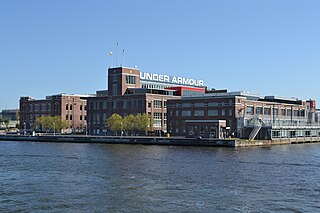
Procter and Gamble Baltimore Plant is a historic factory complex located at Locust Point in Baltimore, Maryland, United States. It is a compact industrial complex built by the national corporation Procter & Gamble comprising five major three-story brick buildings spread over 10 acres (40,000 m2). These major buildings are the Process Building (1929), the Soap Chip Building (1929), the Bar Soap Building (1929), the Warehouse (1929), and the Tide Building (1949).

Hallville Mill Historic District is a historic district in the town of Preston, Connecticut, that was listed on the National Register of Historic Places in 1996. Contributing properties in the district are 23 buildings, two other contributing structures, and one other contributing site over a 50-acre (20 ha) area. The district includes the dam that forms Hallville Pond, historic manufacturing buildings and worker housing, and the Hallville Mill Bridge, a lenticular pony truss bridge built circa 1890 by the Berlin Iron Bridge Company.

The Building at 202 W. Third Street, also known as the M.D. Petersen Estate Building, is a historic building located in downtown Davenport, Iowa, United States. It has been individually listed on the National Register of Historic Places since 1983. In 2020 it was included as a contributing property in the Davenport Downtown Commercial Historic District.

Bellefonte Historic District is a national historic district located at Bellefonte, Centre County, Pennsylvania. The district encompasses 296 contributing buildings in the central business district and surrounding residential area of Bellefonte. The oldest building in the district is the Col. James Dunlop House dated to 1795. Notable non-residential buildings include the St. John's Roman Catholic Church, Crider Exchange (1889), Temple Court Building (1894), First National Bank Building, W.F. Reynolds and Co. Bank Building, and Pennsylvania Railroad Station. Located in the district and listed separately are the Brockerhoff Hotel, Centre County Courthouse, Gamble Mill, McAllister-Beaver House, and Miles-Humes House. The Bellefonte Academy and the Bush House Hotel were previously listed on the register until they burned to the ground in 2004 and 2006, respectively.
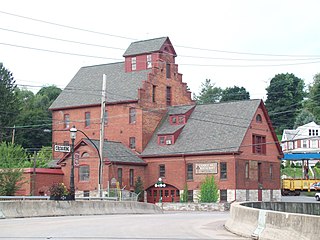
Gamble Mill, also known as Lamb Mill, Thomas Mill, Wagner Mill, and Bellefonte Flouring Mill, is an historic grist mill located at Bellefonte, Centre County, Pennsylvania.

The Waterloo East Commercial Historic District is a nationally recognized historic district located in Waterloo, Iowa, United States. It was listed on the National Register of Historic Places in 2011. At the time of its nomination the district consisted of 36 resources, including 28 contributing buildings, and eight non-contributing buildings. The city of Waterloo was established in the early 1850s. Its first settlers started developing the west side of the city before crossing the Cedar River and developing east side. The first Black Hawk County Courthouse was built on the east side in 1856 and East Waterloo Township was created two years later. As industry began to develop along the river, and the arrival of the first railroad in 1861, the commercial district on the east side began to grow. Also on the east side of town was the terminus of the streetcar-turned-interurban system. By 1900, the city became one of the primary wholesale and retail centers in northeastern Iowa. In 1911 the Black population increased significantly as workers, primarily from Mississippi, moved into town to work for the Illinois Central Railroad. The following year the saloons in town were closed and bootlegging, gambling, drugs, and prostitution started to increase in the area surrounding the central business district. All of these developed put together created the atmosphere of the downtown commercial district.

The Davenport Motor Row and Industrial Historic District or Pete Stopulos Row is a nationally recognized historic district located on the eastern edge of downtown Davenport, Iowa, United States. It was listed on the National Register of Historic Places in 2019.





















